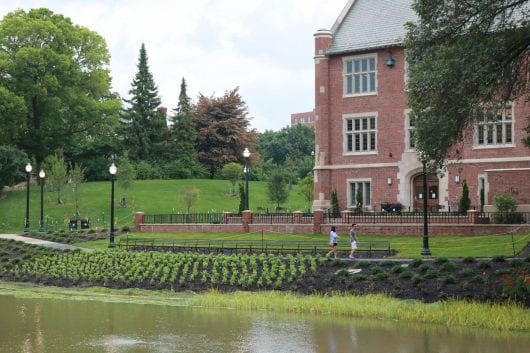
After two years, Mirror Lake District was opened to the public in August with a new and improved Pomerene Hall. Credit: Amal Saeed | Assistant Photo Editor
The Historic Mirror Lake District that has been under construction since fall 2016, which included the renovation of Mirror Lake, Browning Amphitheater and Pomerene and Oxley halls, officially removed its fences Aug. 10. The project budgets were more than $69 million, collectively.
Dan Hedman, a spokesperson for Ohio State, said the projects were simultaneously considered and are consistent with the university’s master plan Framework 2.0, the overarching updates to Ohio State’s campus, buildings and size, with a focus to create “modern learning environments.”
Mirror Lake, which used to be 4 feet deep uniformly, is shallower with gradual slopes and is 4 feet at its deepest point.
The university did not comment on whether the lake’s depth change was to prevent the student tradition of jumping into the lake the Tuesday prior to the Ohio State-Michigan football game.
The lake’s renovation, which received an $8.5 million budget, also included Wi-Fi accessibility, additional seating, walkways, trees, shrubs and wetland plants, focusing on safety and sustainability.
“The project returns the lake closer to its historical form — while emphasizing improved stormwater management, reducing chemical water treatments and increasing overall biodiversity,” Hedman said.
Pomerene Hall, which was originally built in 1922, was reconstructed to become the new home for Ohio State’s Translational Data Analytics Institute, undergraduate data analytics major and the Department of History of Art, with a new addition built to replicate the features of the original building. The $59 million project was state-funded.
According to a news release, part of the historic building’s renovation included the gymnasium that was part of the university’s women’s student union, to host state-of-the-art labs for “building hardware, testing software and conducting large-scale visualization analysis and data simulations.”
The hall also will house the new dining facility Mirror Lake Eatery.
Browning Amphitheater received a budget of $920,000 to upgrade and restore the foundation.
“The Browning Amphitheatre restoration was to maintain its historical integrity as a landmark on Ohio State’s Columbus campus,” Hedman said. “Construction teams restored and upgraded the amphitheater’s infrastructure — enhancing safety.”


